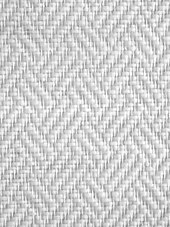Fiberglass wallpaper
The glass fiber wallpaper, also known as "glass decorative fabric" or "glass fabric wallpaper", is an extremely hard-wearing, paintable textured wall covering made of glass fiber .
Manufacturing
The glass fiber wallpaper is made from industrially manufactured glass fibers, which are created by drawing molten glass into thin threads. These glass fibers are processed into a glass fabric in weaving machines . The subsequent finishing of this fabric gives the glass fiber wallpaper its final properties.
properties
Durability
Fiberglass wallpapers stand out from other comparable wall coverings primarily through their mechanical strength and durability, which qualifies them especially for use in heavily frequented rooms and public buildings. Due to their properties, they are considered to be the most durable wallpapers in the world. The tensile strength of the fiberglass wallpaper exceeds that of the woodchip wallpaper by about seven times and that of the vinyl wallpaper by more than twice. Due to these properties, the glass fiber wallpaper has a special wall-reinforcing function. Existing cracks in the plaster can be preserved and the formation of new cracks prevented. In addition, the wall is permanently protected against damage from impacts.
Due to the mineral origin of the basic substances, the glass fiber wallpaper goes completely into the building.
Fire retardant
Glass fiber wallpaper is flame retardant (B1 according to DIN 4102). Since no fire-retardant, toxic additives have to be used in production, no toxic gases are produced in the event of a fire.
Other properties
Fiberglass wallpapers are dimensionally stable, dimensionally stable when wet, rot-proof, can be repainted and are characterized by a long service life.
economics
Fiberglass wallpapers are more expensive to buy than vinyl or woodchip wallpapers. Fiberglass wallpapers can be painted over up to ten times without affecting the structural appearance. This increases the renovation intervals significantly. The life expectancy of a glass fiber wallpaper is stated to be up to 30 years. Due to this longevity, the slightly higher acquisition costs are amortized.
Health compatibility
Fiberglass wallpapers do not provide a breeding ground for mold and spores (unlike cellulose- based wall coverings). In addition, the wall coverings are washable and disinfectable with the appropriate coating and are therefore particularly suitable for allergy sufferers. Due to the thickness of the glass fibers of 8 to 10 micrometers, glass fibers cannot get into the lungs, so there is no danger to the airways. In addition, the fibers are firmly fixed by finishing, glue and paint. Slight skin irritations are possible during processing. After painting over, all fibers are bound and no further impairment is possible.
ecology
Fiberglass wallpapers are ecologically harmless. The products of well-known manufacturers are certified according to Oeko-Tex Standard 100.
particularities
- Using jacquard patterns, complex patterns such as company logos can also be displayed.
- Glass fabric wallpapers with self-adhesive equipment can save embedding glue. They are fixed to the surface that has been prepared for wallpapering thanks to their weakly adhesive properties. The final adhesive bond is achieved by a special adhesive coating that usually exists in the system. The coating penetrates the fabric and sticks it to the substrate.
- Pigmented or pre-pigmented fiberglass wallpapers have a factory-applied primer coat on the top of the fabric. This saves the intermediate coat and the final coat can be applied immediately after the adhesive has dried. In addition, fewer and sometimes very itchy glass fibers loosen from the fabric when wallpapering.
Special areas of application
operating room
By combining it with a silk latex paint, fiberglass wallpapers can be used in highly hygienic areas. Like tiles, the fiberglass wallpapers are easy to clean, but have no joints that can become porous and thus offer ideal growth conditions for bacteria .
Kitchen Bath
In connection with a polyurethane coating , absolutely closed surfaces are created, deposits from vapors can be washed off. In addition, the fiberglass wallpapers are insensitive to moisture, abrasion-proof and rot-proof even when they come into contact with water and grease.
nursery
Due to their strong durability and harmlessness to health, they are also suitable for use in children's rooms. The possibility of repainting the wallpaper guarantees the adaptation to the individually changing requirements of a wall covering.
Manufacturer
- Vitrulan
- PD glass fiber Brattendorf
- Saint-Gobain Vetrotex
- John's Manville
- others in Asia
swell
- The painter and master finisher; 1/2008; Verlag W. Sachon Removing fiberglass wallpaper: You have to pay attention to this. Retrieved January 11, 2019 .
- Painter's sheet; 8/2004; Pp. 40-41; Konrad Medien Verlag
- Painter's sheet; 12/2005; Pp. 42-43; Konrad Medien Verlag
- Article on Baumann-online.de ( Memento from July 4, 2010 in the Internet Archive )

